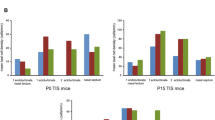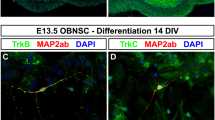Abstract
Olfactory dysfunction has been implicated in various neurodegenerative diseases including Parkinson's and Alzheimer's disease but, despite intense interest in the neurobiology of the olfactory bulb (OB), studies of neurodegenerative mechanisms have not been attempted in primary OB cultures. This study was aimed at developing a primary OB culture under serum-free conditions in order to investigate injury and excitotoxicity in vitro. Olfactory bulbs from rat pups were rapidly trypsinised and mechanically dissociated and the resultant single cell suspension was centrifuged through a high bovine serum albumin concentration gradient to reduce cellular debris before being seeded in multi-well culture plates. Cells were plated in neurobasal medium containing 0.5 mM glutamine, 25 mM K+, 2% B27 and 10% fetal calf serum (FCS) for 24 h and, after 1 day in vitro (div1), were maintained without FCS. At div8, neurones exhibited extensive neuritic networks, were present as a monolayer and were mainly bipolar and immunopositive for γ-aminobutyric acid indicating that they were intrinsic OB neurones. At div8, neurones (positive for microtubule-associated protein-2, 73%) predominated over astrocytes (positive for glial fibrillary acidic protein, 27%). Cellular injury produced by staurosporine, hydrogen peroxide and kainate, when assessed by morphological and biochemical procedures, was shown to be concentration-dependent and significantly reduced the numbers of neurones and astrocytes. Further analyses of kainate-induced injury revealed the presence of TUNEL-positive cells (indicative of apoptosis) and increases in intracellular free calcium, both of which were antagonised by CNQX. Thus, the serum-free culture developed here is amenable to morphological and high throughput neurochemical analyses of mechanisms contributing to the injury of OB neurones in vitro.


Similar content being viewed by others
References
Alvarez-Buylla A, Seri B, Doetsch F (2002) Identification of neural stem cells in the adult vertebrate brain. Brain Res Bull 57:751–758
Bischofberger J, Schild D (1995) Different spatial patterns of [Ca2+] increase caused by N- and L-type Ca2+ channel activation in frog olfactory bulb neurones. J Physiol 487(Pt 2):305–317
Bonfoco E, Krainc D, Ankarcrona M, Nicotera P, Lipton SA (1995) Apoptosis and necrosis: two distinct events induced, respectively, by mild and intense insults with N-methyl-D-aspartate or nitric oxide/superoxide in cortical cell cultures. Proc Natl Acad Sci U S A 92:7162–7166
Brennan PA, Keverne EB (1997) Neural mechanisms of mammalian olfactory learning. Prog Neurobiol 51:457–481
Brewer GJ (1995) Serum-free B27/neurobasal medium supports differentiated growth of neurons from the striatum, substantia nigra, septum, cerebral cortex, cerebellum, and dentate gyrus. J Neurosci Res 42:674–683
Brewer GJ (1997) Isolation and culture of adult rat hippocampal neurons. J Neurosci Methods 71:143–155
Carleton A, Petreanu LT, Lansford R, Alvarez-Buylla A, Lledo PM (2003) Becoming a new neuron in the adult olfactory bulb. Nat Neurosci 6:507–518
Carlson GC, Slawecki ML, Lancaster E, Keller A (1997) Distribution and activation of intracellular Ca2+ stores in cultured olfactory bulb neurons. J Neurophysiol 78:2176–2185
Cheung NS, Pascoe CJ, Giardina SF, John CA, Beart PM (1998) Micromolar L-glutamate induces extensive apoptosis in an apoptotic-necrotic continuum of insult-dependent, excitotoxic injury in cultured cortical neurones. Neuropharmacology 37:1419–1429
Coronas V, Durand M, Chabot JG, Jourdan F, Quirion R (2000) Acetylcholine induces neuritic outgrowth in rat primary olfactory bulb cultures. Neuroscience 98:213–219
Cunningham AM, Manis PB, Reed RR, Ronnett GV (1999) Olfactory receptor neurons exist as distinct subclasses of immature and mature cells in primary culture. Neuroscience 93:1301–1312
DeGregorio-Rocasolano N, Gasull T, Trullas R (2001) Overexpression of neuronal pentraxin 1 is involved in neuronal death evoked by low K(+) in cerebellar granule cells. J Biol Chem 276:796–803
Frosch MP, Dichter MA (1984) Physiology and pharmacology of olfactory bulb neurons in dissociated cell culture. Brain Res 290:321–332
Gage FH (2000) Mammalian neural stem cells. Science 287:1433–1438
Hawkes C (2003) Olfaction in neurodegenerative disorder. Mov Disord 18:364–372
Henderson CE, Bloch-Gallego E, Camu W (1995) Purified embryonic motoneurons. In: Cohen J, Wilkin GP (eds) Neural cell culture–a practical approach. Oxford University Press, New York, pp 69–81
Hoogland PV, van den Berg R, Huisman E (2003) Misrouted olfactory fibres and ectopic olfactory glomeruli in normal humans and in Parkinson and Alzheimer patients. Neuropathol Appl Neurobiol 29:303–311
Horning MS, Trombley PQ (2001) Zinc and copper influence excitability of rat olfactory bulb neurons by multiple mechanisms. J Neurophysiol 86:1652–1660
Kovacs T, Cairns NJ, Lantos PL (1999) Beta-amyloid deposition and neurofibrillary tangle formation in the olfactory bulb in ageing and Alzheimer's disease. Neuropathol Appl Neurobiol 25:481–491
Larm JA, Cheung NS, Beart PM (1997) Apoptosis induced via AMPA-selective glutamate receptors in cultured murine cortical neurons. J Neurochem 69:617–622
Moldrich RX, Giardina SF, Beart PM (2001) Group II mGlu receptor agonists fail to protect against various neurotoxic insults induced in murine cortical, striatal and cerebellar granular pure neuronal cultures. Neuropharmacology 41:19–31
Moldrich RX, Aprico K, Diwakarla S, O'Shea RD, Beart PM (2002) Astrocyte mGlu(2/3)-mediated cAMP potentiation is calcium sensitive: studies in murine neuronal and astrocyte cultures. Neuropharmacology 43:189–203
Petreanu L, Alvarez-Buylla A (2002) Maturation and death of adult-born olfactory bulb granule neurons: role of olfaction. J Neurosci 22:6106–6113
Schild D, Geiling H, Bischofberger J (1995) Imaging of L-type Ca2+ channels in olfactory bulb neurones using fluorescent dihydropyridine and a styryl dye. J Neurosci Methods 59:183–190
Tissingh G, Berendse HW, Bergmans P, DeWaard R, Drukarch B, Stoof JC, Wolters EC (2001) Loss of olfaction in de novo and treated Parkinson's disease: possible implications for early diagnosis. Mov Disord 16:41–46
Trombley PQ, Shepherd GM (1992) Noradrenergic inhibition of synaptic transmission between mitral and granule cells in mammalian olfactory bulb cultures. J Neurosci 12:3985–3991
Trombley PQ, Westbrook GL (1990) Excitatory synaptic transmission in cultures of rat olfactory bulb. J Neurophysiol 64:598–606
Yamada M, Onodera M, Mizuno Y, Mochizuki H (2004) Neurogenesis in olfactory bulb identified by retroviral labeling in normal and 1-methyl-4-phenyl-1,2,3,6-tetrahydropyridine-treated adult mice. Neuroscience 124:173–181
Acknowledgements
The authors thank Nicole Jones, Shanti Diwakarla, Chrissandra Zagami and Randal Moldrich for their advice and encouragement.
Author information
Authors and Affiliations
Corresponding author
Additional information
This work was supported by a Program Grant (no. 236805) from NH&MRC (Australia), of which P.M.B. is a Research Fellow.
Rights and permissions
About this article
Cite this article
Farso, M.C., Carroll, F.Y. & Beart, P.M. Establishment of primary cultures of rat olfactory bulb under serum-free conditions for studies of cellular injury. Cell Tissue Res 323, 343–349 (2006). https://doi.org/10.1007/s00441-005-0056-5
Received:
Accepted:
Published:
Issue Date:
DOI: https://doi.org/10.1007/s00441-005-0056-5




